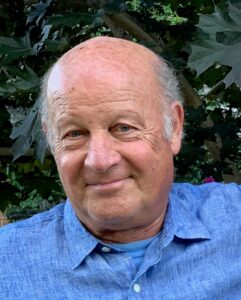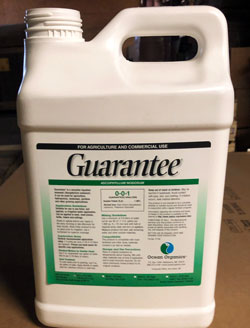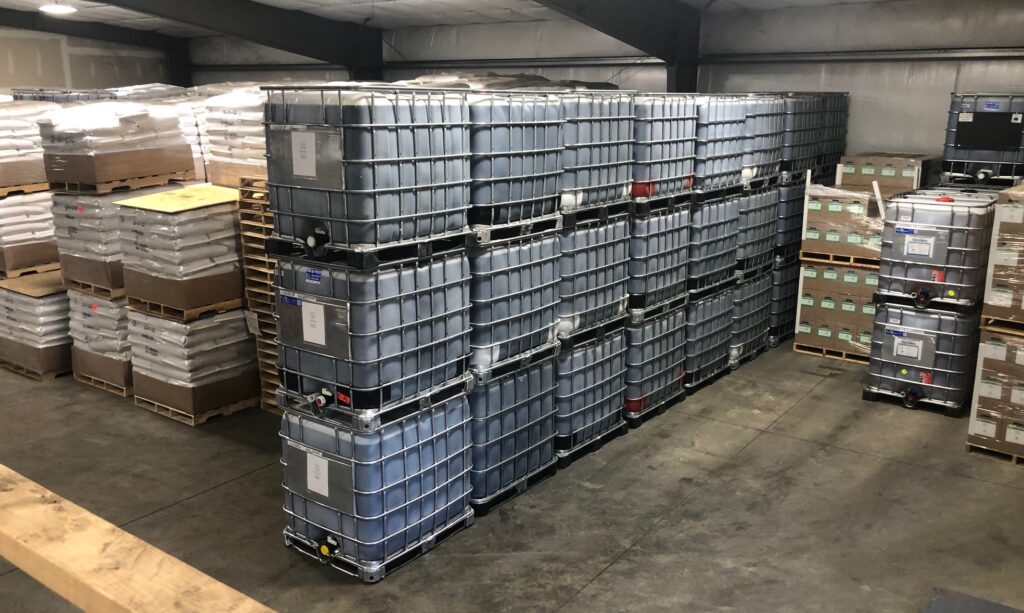Seaweed has been used as a soil amendment for as long as crops have been grown, with documented use dating to the Roman Empire. In Maine, it was used by indigenous people, and then during the colonial period, hauled in wagons from the shore.
It remains in use today, and the enriching elements of Maine rockweed are nourishing golf courses and potato fields as far away as California, thanks to Ocean Organics, a company based in Waldoboro’s business park.
The company’s vice-president George Seaver is a passionate advocate for the industry, and he worries the supply of rockweed—harvested from the intertidal zone—may be threatened by recent court rulings, which he calls “troubling.”
“It’s sort of a niche. We’re shipping products all over the world.”
That concern is well-founded, given the landmark ruling by the state’s supreme court in Ross vs. Acadian Seaplants, which found that rockweed growing between the low tide and high tide lines was owned by the “upland” landowner. That landowner could deny harvesters access to the plant, even if the cutting was done from a boat.
For now, Seaver’s business is getting the rockweed it needs. And the 4-foot-cubes sitting in the parking lot, bound for customers across the country and Canada, attest to the demand for the product.

Seaver moved to Maine from Connecticut in 1977, inspired by a story in Down East magazine about early seaweed entrepreneur Bob Morse.
“That’s what kind of got me up here,” he said during a conversation in the office adjacent to the company’s plant. Seaver worked for Morse from 1977 to 1991. The business, Atlantic Laboratories, dries seaweed and makes liquid extracts, among other uses. Though rockweed has been sustainably harvested in Maine for a long time—Seaver says it was cut in Boothbay Harbor in the 1860s, used to fertilize tobacco fields in Connecticut—there is opposition to the practice today.
“We are viewed by conservation groups as evil industrialists who are going to ruin the shore,” he says. “We’re kind of the good guys, but we’re perceived as not,” he says, arguing that over-harvesting or cutting the rockweed—which, as its name implies, attaches itself to rock—too severely would be bad business.
“It’s completely counter-productive to have a short view of the resource,” he says.
Most rockweed in Maine is harvested in the Downeast part of the state where tidal ranges are greatest, though the plant can be found as far south as Rhode Island.
Ocean Organics was born from Atlantic Laboratories, also located at the Waldoboro site. “We compete a little bit, but not as much as you would think,” Seaver says. Between the two businesses, more rockweed is processed here than anywhere else in the state.
A customer in Michigan purchasing from Atlantic Laboratories wanted a dedicated source to provide its product, and so Ocean Organics was established. Since then, the business has developed other customers.
“It’s sort of a niche,” he says. “We’re shipping products all over the world.”
Seaver is careful about sharing competitive specifics but explains the product is a sort of tea made from the rockweed with other substances added. The business purchases “several hundred tons a year” of rockweed, harvested by independent contractors from a couple locations on the coast.

The product is delivered to customers in 4-foot square totes, hauled on tractor-trailer trucks, and sold in 2.5-gallon containers, often as a “private label,” meaning the individual customer then mixes in additives tailored to the use. One common use of the product is to fertilize golf courses, though Seaver reports that potato fields have seen 5% to 15% increases in yield when the product is applied.
“A lot of it gets on potatoes,” he said. When the economy crashed in 2009, the company pivoted from golf courses to agricultural customers. Export markets in South Korea, Japan, and China are being developed.
“We spend well over $100,000 a year on research,” he says, working with Cornell, Rutgers, Virginia Tech, and others.
A dried product made from the residue of the liquid-making process is also sold. “We make some really good, granulated fertilizers used on some of the best golf courses in the country.”
But will this business, which employs about two dozen at the Waldoboro plant, remain as constant as the resource it extracts? Seaver worries courts may be out of their depth when it comes to ruling on matters intertidal.
At the root of the legal wrangling is a nearly 400-year-old piece of legislation that still holds sway. The Colonial Ordinance of 1647 stipulates that access to the intertidal zone is permitted for three general purposes: fishing, fowling, and navigation. The state defines harvesting seaweed as fishing, Seaver says, and he believes the court’s ruling is in conflict with current Maine law.
But Seaver argues that the ordinance’s language was about proprietors, who were allowed to build docks, and suggests that it gave control of the intertidal zone to shorefront business owners, not ownership of the property in the intertidal zone.
If shorefront landowners do indeed control the intertidal zone, he argues they should confirm ownership through title searches, be taxed on that property, and be responsible for marking it.
Environmentalists argue that harvesting is harmful to the habitat rockweed creates. Seaver counters that harvesters must leave 16 inches of plant, and that mechanical devices are designed to avoid overharvesting. One analogy is that it’s like cutting fir boughs to make wreaths—the plant survives and thrives from the pruning.
Despite what seems to be a trend toward restricting harvesting, Ocean Organics is thriving. Seaver gives a tour of an unused industrial building across the street in which the operation will expand.





